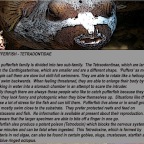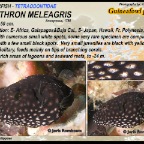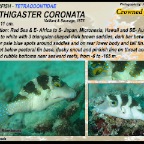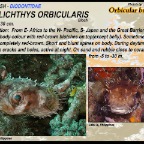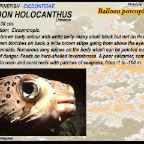Pufferfish & relatives
PUFFERFISH - TETRADONTIDAE
The pufferfish family is divided into two sub-family. The Tetraodontinae, which are larger than the Canthigasterinae, which are smaller and are a different shape. ‘Puffers’ as most people call them are slow but skill-full swimmers. They are able to rotate like a helicopter and swim backwards. When feeling threatened, they are able to enlarge their body by sucking in water into a stomach chamber in an attempt to scare the intruder. Sadly though there are always those people who like to catch pufferfish because they find they look funny and photogenic when they blow themselves up. Situations like this cause a lot of stress for the fish and can kill them. Pufferfish live alone or in small groups and mostly swim close to the substrate. They prefer protected reefs and feed on crustaceans and fish. No information is available at present about their reproduction. Be aware that the larger specimen are able to bite off a finger in one go. Pufferfish also produce a potent poison (Tetrodoxin) which blocks the nervous system in a few minutes and can be fatal when ingested. This Tetrodoxine, which is formed by bacteria in red algae, can also be found in certain gobies, slugs, crustacean, starfish and the blue ringed octopus. Length: 30 cm.Distribution: Circumtropic.Creamy brown body colour with white belly, many small black but not on fins.Four brown blotches on back, a wide brown stripe going from above the eyes towards the bottomside. Numerous long spines on the body which can be pointed outwards incase of danger. Feeds on hard-shelled invertebrates. A poor swimmer, sometimes in group. On rock- and coral reefs with patches of seagrass, from -1 to -100 m. Length: 71 cm.Distribution: Tropical, subtropical and warm temperate seas.Pinkish-yellow-brown with pale belly. Numerous black spots all over the body, same as all the short spines which can be put upwards. Lives solitary, except during mating season.On coral and rocky reefs to -50 m. Length: 34 cm.Distribution: Red Sea, the Gulf of Oman to Indonesia, Philippines and Galapagos(rare).Grey to brown with a light underside, yellow triangular spines on the side of the body. Three darker brown blotches on the side. On seagrass beds, sandy areas and wrecks, from -3 to -90 m. Becomes active late afthernoon. Length: 30 cm.Distribution: from E- Africa to the W- Pacific, S- Japan and the Great Barrier Reef.Pinkish body-colour with red-brown blotches on top(except belly). Sometimes the top-part is completely red-brown. Short and blunt spines on body. During daytime mostly hiding in cracks and holes, active at night. On sand and rubble close to coral reefs, from -5 to -30 m. Length: 11 cm.Distribution: from Indonesia and Philippines to Palau, G.B.R. and New Caledonia.Very similar to Cathigaster solandri who has bigger spots and white to yellow belly. Brownish body colour covered with small blue spots(including tail), blue lines on the snout and back. Ocellus on dorsal fin base, orange around the mouth.Lives around coral-rich reefs, from -3 to -35 m. Solitary or in pairs. Length: 10 cm.Distribution: Red Sea to S- Japan, Micronesia, French Polynesia and SE- Australia.White ground colour with yellow to light brown spots, lines on snout and head.Four dark brown saddles on the back from which two go towards the belly.Territorial males have a harem with 2 to 7 females. Mimicked by Paraluteres prionurus. Feeds on algae and bentic invertebrates. In lagoons and seaward reefs, from -1 to -55 m. Length: 12 cm.Distribution: from Indonesia to SW- Japan, Mariana Is, Solomon Is. and Vanuatu.Brown upper body, under body from pale brown to white. Green-orange tail fin withvery fine bluish bars. Numerous white to green-blue lines or spots covering the upper body. Ocellus below dorsal fin base. Lives solitary or in pairs among sandy areas of silty bays, shallow lagoons and harbours, from -2 to -25 m. Length: 120 cm.Distribution: Red Sea & S- Africa to S- Japan, Fr. Polynesia and NW- New Zealand.Adults: pale grey-brown body with numerous dark spots, white under-side.Irregular dark blotches at pectoral fin base. Juveniles are yellow with black lines, these lines change into spots with growth. Solitary and territorial, in lagoons and on seaward reefs from -3 to -58 m. Length: 33 cm.Distribution:E- Africa to SW- Japan, Line Is, French Polynesia, G.B.R.and New zealand.Very variable in colour and pattern, mostly white with brown, yellow, blue or olive green. Dark brown to black lips and around the mouth, dark pectoral fin base.Feeds on living corals, cnidarians, crustaceans and molluscs.Among coral-rich areas in lagoons and seaward reefs, from -3 to -25 m. Length: 50 cm.Distribution: E- Africa, Galapagos&Baja Cal., S- Japan, Hawaii, Fr. Polynesia, Australia.Black with numerous small white spots, some very rare specimen are completely yellow with a few small black spots. Very small juveniles are black with yellow-orange spots. Solitary, feeds mainly on tips of branching corals. In coral-rich areas of lagoons and seaward reefs, to -24 m. Length: 65 cm.Distribution: from E- Africa to SW- Japan, Samoa, G.B.R. and New Caledonia.Greyish-brown with a maze looking pattern, white or yellow belly. Radiate lines aroundthe eyes, spotted black blotch around base of pectoral fin andon the side of belly. Juveniles, pale brown with yellow-margined brown to black net-pattern. Yellow and black belly with white spots. Solitary, in lagoons and on rock-or coral reefs to -30 m.
Length: 31 cm.Distribution: from Borneo and Bali to S.W- Japan, Tonga and E.- and W- Australia.Grey to cream with horizontal lines, dark brown blotch at base of pectoral fin.Dark margin on tail fin. Juveniles have pale lines, swim mostly between mangroves.On seagrass beds, weedy areas, sand and silty bottoms of lagoons and coastal areas. From -2 to -20 m. Length: 28 cm.Distribution: from the Red Sea and E- Africa to China, SW- Japan and Indonesia.Upper part brown-grey, lower part gradating to white. Dark spot at pectoral fin base,often with a black margin. Grey to yellow tail with black edges. Yellow to orange iris. Solitary, near mangroves, seagrass beds, weedy or silty bottoms of coastal reefs. From -1 to -30 m. Length: 70 cm.Distribution: from the Maldives to Palau and Fiji.Greyish background covered with small blue spots, blue rings around the eyes.Mostly with an olive green back, normally also with a black patch with white dots onthe pectoral fin base. Solitary and shy, on rock- and coral reef slopes. Prefers outerreefs, from -5 to -35 m.


